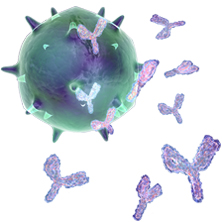Carneiro NS, Alves CCF, Alves JM, Egea MB, Martins CHG, Silva TS, Bretanha LC, Balleste MP, Micke GA, Silveira EV, Miranda MLD Anais da Academia Brasileira de Ciências, 2017 ABSTRACT: Many essential oils (EOs) of different plant species possess interesting antimicrobial effects on buccal bacteria and antioxidant properties. Eugenia klotzschiana Berg (pêra-do-cerrado, in Portuguese) is a species of Myrtaceae with restricted distribution in the Cerrado…. Read more »

This system includes the lymph nodes, white blood cells, lymphatic vessels, thymus gland, bone marrow, spleen and leukocytes. Common disorders include anything with bacterial, viral or fungal origins, leukemia, allergic reactions and autoimmune diseases like lupus or rheumatoid arthritis.
Antifungal mechanism of the combination of Cinnamomum verum and Pelargonium graveolens essential oils with fluconazole against pathogenic Candida strains
Essid R, Hammami M, Gharbi D, Karkouch I, Hamouda TB, Elkahoui S, Limam F, Tabbene O Applied Microbiology and Biotechnology, 2017 ABSTRACT: The present study aimed to investigate the anti-Candida activity of ten essential oils (EOs) and to evaluate their potential synergism with conventional drugs. The effect on secreted aspartic protease (SAP) activity and the mechanism of action were also explored. The… Read more »
Chemical characterization, toxicology and mechanism of gastric antiulcer action of essential oil from Gallesia integrifolia (Spreng.) Harms in the in vitro and in vivo experimental models
Arunachalam K, Balogun SO, Pavan E, de Almeida GVB, de Oliveira RG, Wagner T, Cechinel Filho V, de Oliveira Martins DT Biomedicine & Pharmacotherapy, 2017 ABSTRACT: Gallesia integrifolia is a Brazilian Amazon tree whose bark decoction is popularly used to treat peptic ulcer. The essential oil from the inner stem bark of G. integrifolia (EOGi) was chemically characterized by GC/MS. The in vitro cytotoxicity… Read more »
Synergistic effects of some essential oils against fungal spoilage on pear fruit
Nikkhah M, Hashemi M, Habibi Najafi MB, Farhoosh R International Journal of Food Microbiology, 2017 ABSTRACT: The development of natural protective agents as alternatives to chemical fungicides is currently in the spotlight. In the present investigation, chemical composition and antifungal activities of thyme, cinnamon, rosemary and marjoram essential oils (EO), as well as synergism of their possible double… Read more »
In vitro evaluation of the antibacterial potential and modification of antibiotic activity of the Eugenia uniflora L. essential oil in association with led lights
Pereira NLF, Aquino PEA, Júnior JGAS, Cristo JS, Vieira Filho MA, Moura FF, Ferreira NMN, Silva MKN, Nascimento EM, Correia FMA, Cunha FAB, Boligon AA, Coutinho HDM, Matias EFF, Guedes MIF Microbial Pathogenesis, 2017 ABSTRACT: Due to the great biodiversity of its flora, Brazil provides combat tools against bacterial resistance with the utilization of natural products with vegetable origin. Therefore, the present study had as its objective to evaluate… Read more »
Efficacy of Eucalyptus cinerea as a Source of Bioactive Compounds for Curative Biocontrol of Crown Gall Caused by Agrobacterium tumefaciens Strain B6
Kahla Y, Zouari-Bouassida K, Rezgui F, Trigui M, Tounsi S BioMed Research International, 2017 ABSTRACT: This research investigated the Eucalyptus cinerea leaves efficiency in the Agrobacterium tumefaciens biocontrol, the causative agent of crown gall. GC-MS analysis of the essential oil (EO) showed that the main components were 1,8-cineole (61%) and camphene (15.13%). Thanks to its polyphenols, flavonoids, quinones, terpenoids, alkaloids, and tannins richness,… Read more »
An in vitro ethnopharmacological study on Prangos ferulacea: a wound healing agent
Yousefi K, Hamedeyazdan S, Hodaei D, Lotfipour F, Baradaran B, Orangi M, Fathiazad F BioImpacts, 2017 ABSTRACT: Introduction: Traditionally Prangos ferulacea root is being used as an effective wound healing agent especially for pus-filled wounds both in human and stocks in the western north of Iran. Regarding the subject we decided to study P. ferulacea roots essential oil (PFE) for its antimicrobial and wound healing activities…. Read more »
Effects of rosemary, thyme and lemongrass oils and their major constituents on detoxifying enzyme activity and insecticidal activity in Trichoplusia ni
Tak JH, Jovel E, Isman MB Pesticide Biochemistry and Physiology, 2017 ABSTRACT: Although there have been many reports on the synergistic interactions among the major constituents of plant essential oils regarding insecticidal activity, their underlying mechanism of synergy is poorly understood. In our previous studies, we found each of the two most abundant constituents of rosemary (Rosmarinus officinalis… Read more »
Antimicrobial activity of copaiba oil: A review and a call for further research
Tobouti PL, de Andrade Martins TC, Pereira TJ, Mussi MCM Biomedicine & Pharmacotherapy, 2017 ABSTRACT: Copaiba oil has been used for more than 390 years, however, considering the time of empirical use, there are a scarce number of publications on its activities. This essential oil is a phytomedicine proven to be efficient against some microorganisms. However, different from other… Read more »
A comparative study of antibacterial and anti-inflammatory effects of mouthrinse containing tea tree oil
Salvatori C, Barchi L, Guzzo F, Gargari M ORAL & Implantology, 2017 ABSTRACT: The study evaluated the antibacterial and anti-inflammatory efficacy, domiciliary oral hygiene, of a mouthrinse containing Tea Tree Oil (TTO) comparing it with two mouthrinses containing chlorhexidine 0,12% respectively and essential oils, and a placebo. MATERIALS AND METHODS: A pilot study, randomized 4 × 4, controlled, cross-over,… Read more »
